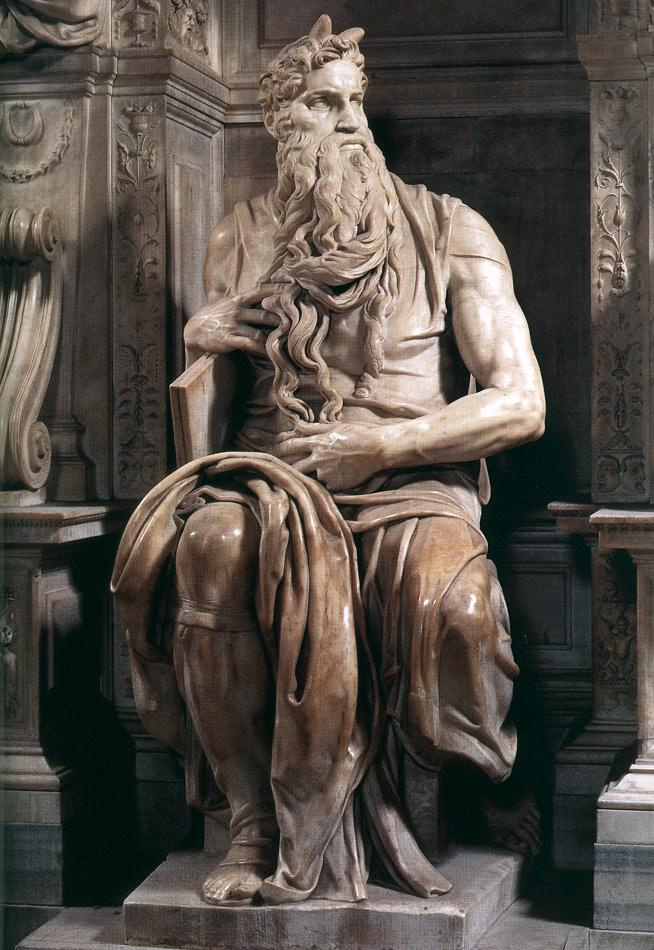
Context
The statue of Moses was created by Michelangelo Buonarotti approximately in 1513-1515. Michelangelo’s previous work, David, quickly gained recognition among the public (Zirpolo 160). Following these events, in 1505, Pope Julius II commissioned the artist to come to Rome to build a tomb (Fenichel 153). Moses was planned to be among several dozens of sculptures of similar size. However, Michelangelo was commissioned to paint the Sistine chapel, and his project for the pope was delayed. Moreover, as Pope Julius II passed away in 1513, the tomb’s design was significantly altered and finished in 1545. Moses became the centerpiece of the composition and placed with the rest of the tomb’s details.
Descriptive Inventory
Moses, similar to other Michelangelo’s statues, is made of white marble. Armour describes the statue as “a larger-than-lifesize, three-dimensional block of marble shaped in a particular, indeed unique, way into a human form” (18). It is a realistic depiction of the prophet, although the man is not of average height – the sculpture is taller than 8 feet, and its placement forces the viewer to look up to see the prophet’s face (Zirpolo 185). Moses is depicted sitting down, but his position appears to be non-static.
Formal Analysis
The majority of descriptions of Moses note the dynamic nature of the prophet’s pose. The right foot is placed firmly on the floor, while his left is put further back, lightly touching the floor. As a result, Moses looks as if he is preparing to stand up. The torso, however, is turned to the right, to the side of his right hand. The prophet rests his arm on and holds the stone tablets with the Ten Commandments given to him by God. Moreover, Moses holds the hair of his long beard – described by scholars as “soft” and “feathery” (Fenichel 156). His left hand is tense, placed on his lap, while his head is turned to the left in what is described as a “violent twist” (Zirpolo vii). Moreover, although the sculpture has proper proportions of the human body, its size and position create an illusion of grandeur.
Technical Aspects
Michelangelo followed a similar process of subtractive sculpture when creating his works. In this case, the sculptor started by drawing the tomb and placing the statues in their supposed positions. Then, he most likely worked with clay or wax to create a model, although no confirmation for this particular sculpture was found. Finally, Michelangelo took a mallet and chisels and started working on a block of white marble transported from a Carrara quarry (Zirpolo 42). The artists did not use any other techniques or materials, simply chipping away at the block and improving the sculpture throughout the years.
Content
It is known that Moses was created as a part of a larger project – a tomb for Pope Julius II. However, Moses was likely chosen by Michelangelo along with other important figures in the establishment of Christianity. Scholars link the pose of Moses and his expression to the Latin translation of the Bible. In particular, the depicted scene is taken from Exodus 33 and 34, where Moses returns from Mt. Sinai with the Ten Commandments. Moreover, his angered expression and tense pose are interpreted as a reaction to seeing the Israelites worship the false idol, a Golden Calf (Zirpolo 122). As such, this sculpture is intended to show the intensity of faith in God and the moments before Moses smashing the Ten Commandments.
Personal Evaluation and Spiritual Reflections
This sculpture has made a strong impression on me both visually and emotionally. Michelangelo’s ability to create dynamic motion is unparalleled – a simple sitting pose is elevated by the shifting directions of the torso, head, and legs. I do not know if I could change anything to improve the sculpture in relation to its emotional intensity. Looking at Moses, I can see the anger and frustration in his face, and I believe that it is the embodiment of God’s word as unyielding and ever-present.
Works Cited
Armour, Peter. “Michelangelo’s Moses: A Text in Stone.” Italian Studies, vol. 48, no. 1, 1993, pp. 18-43.
Fenichel, Emily A. “Michelangelo’s Moses in the 1540s.” Notes in the History of Art, vol. 40, no. 3, 2021, pp. 153-163.
Zirpolo, Lilian H. Michelangelo: A Reference Guide to His Life and Works. Rowman & Littlefield Publishers, 2020.